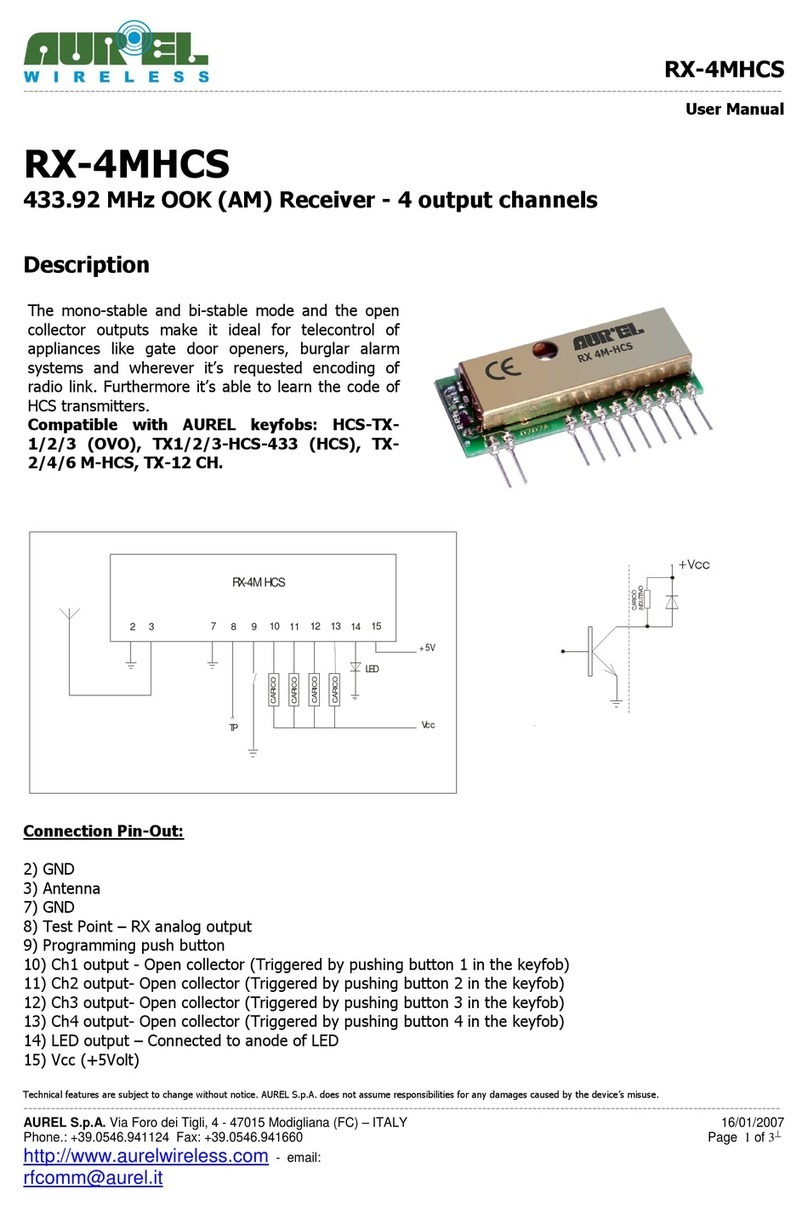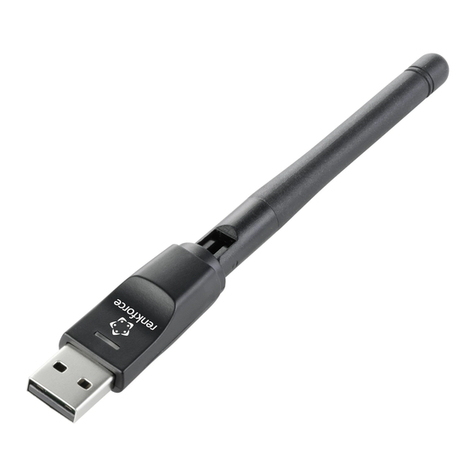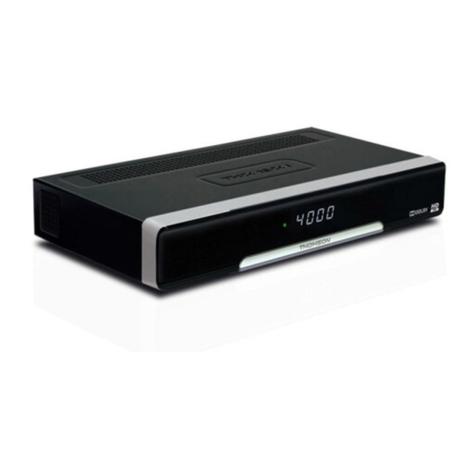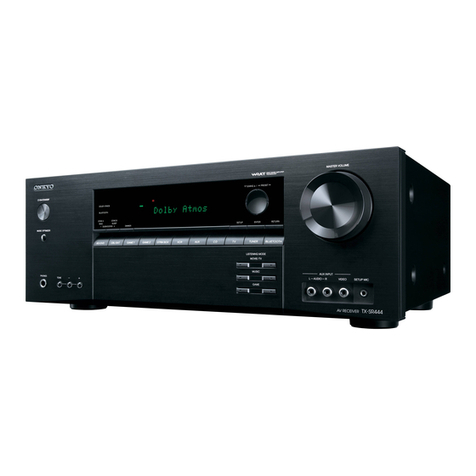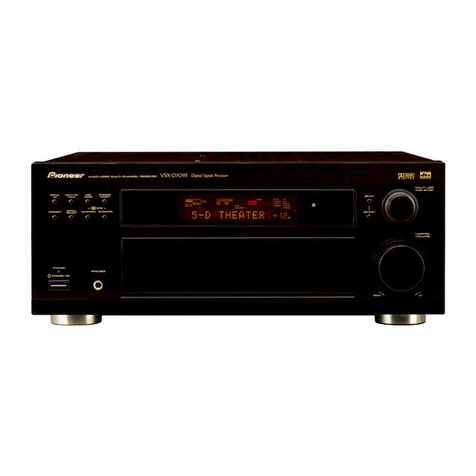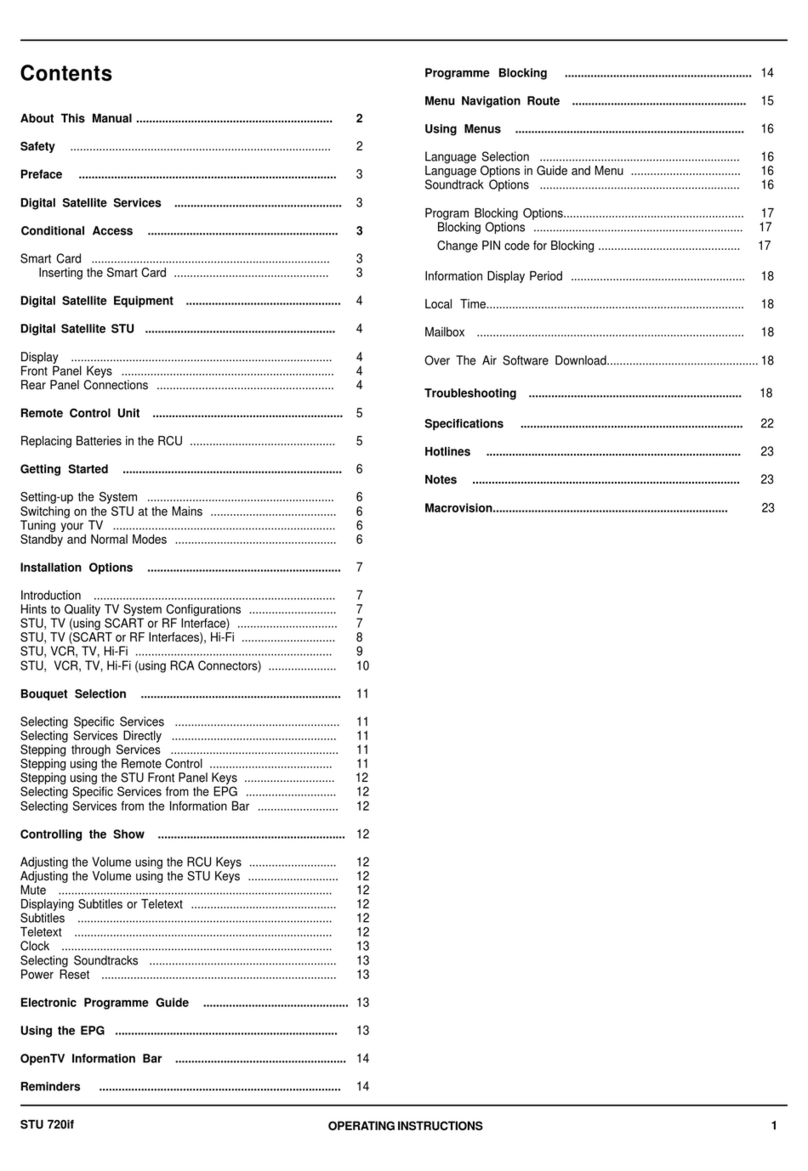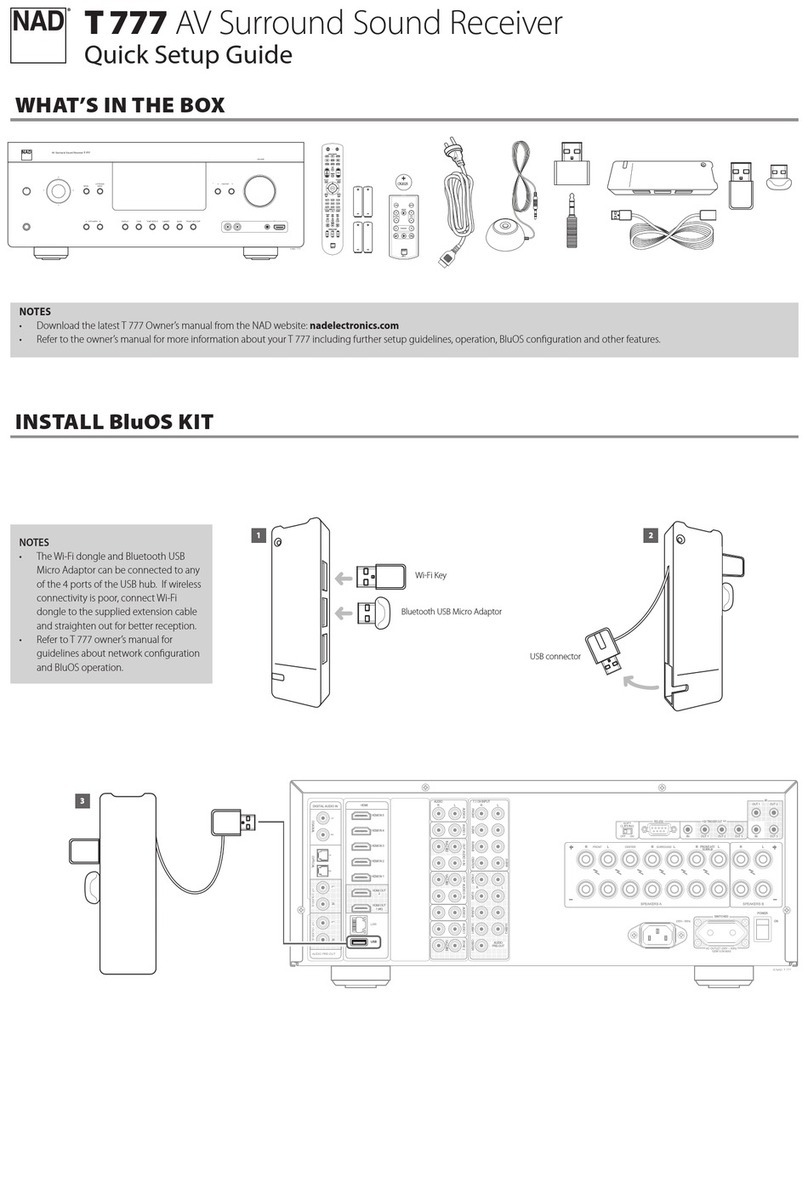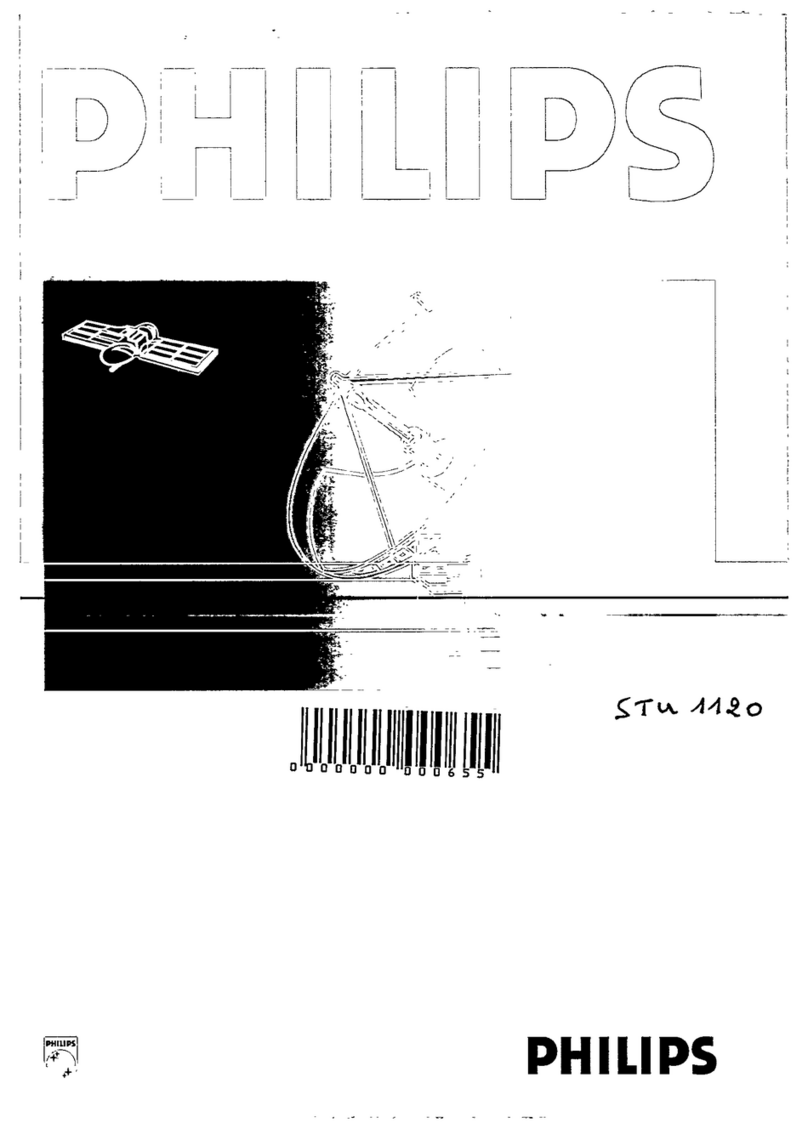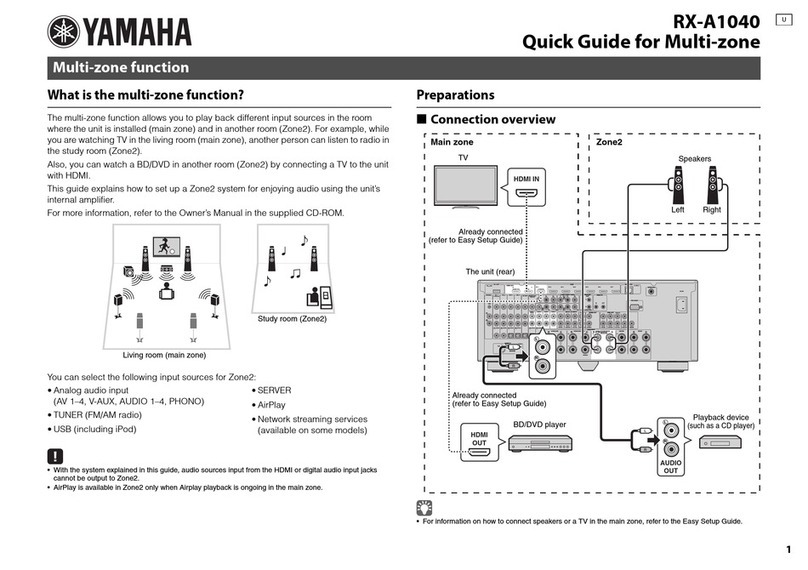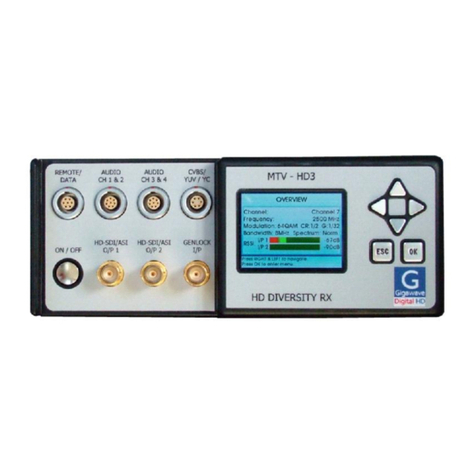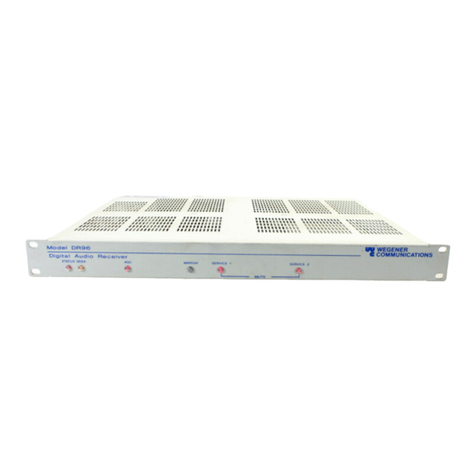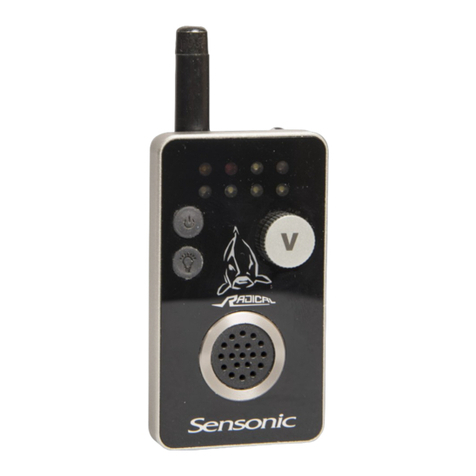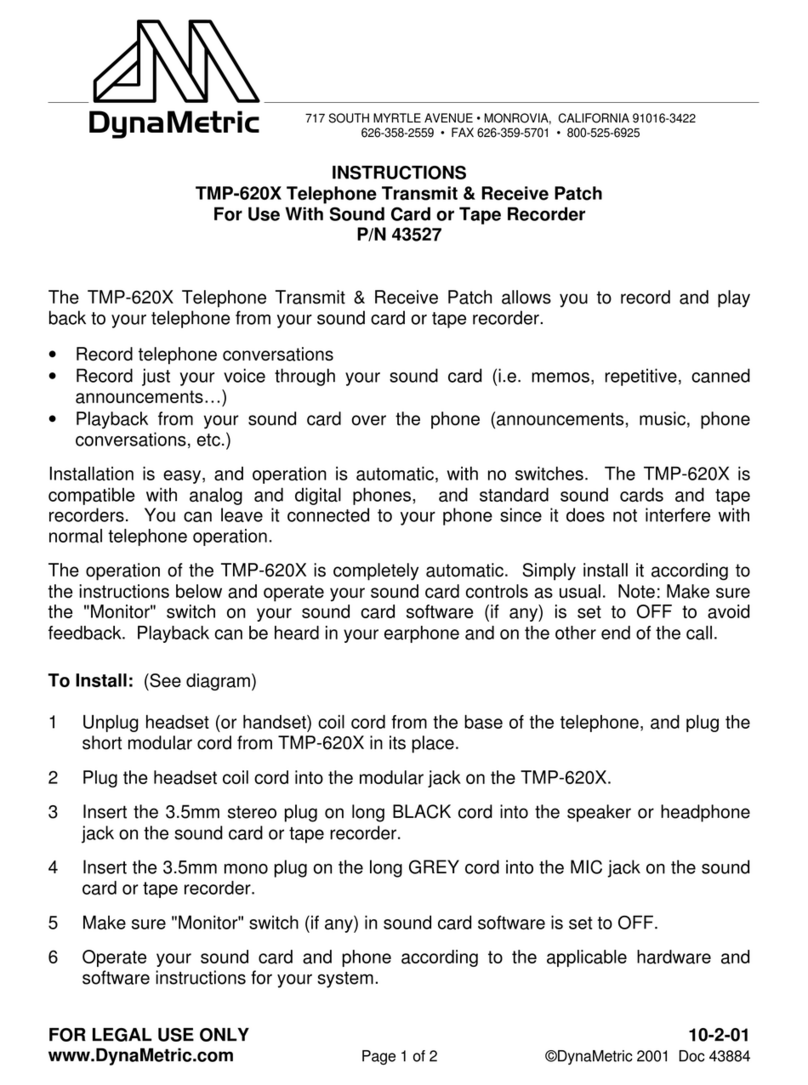TIL TiL-92-SC User manual

VHF/AM SINGLE CHANNEL
RECEIVER Model TiL-92-SC
92-SC RECEIVER P/N 931040-1
(ITEM NO. TSR-4100)
Installation and
Operating Instructions
TiL Document No. 93RE125
Rev. F
JULY 2012
Technisonic Industries Limited
240 Traders Boulevard, Mississauga, Ontario L4Z 1W7
Tel: (905) 890-2113 Fax: (905) 890-5338
www.til.ca
Copyright by Technisonic Industries Limited. All rights reserved.


ii
REVISION HISTORY
[ 93RE125 ]
REV SECTION
- PAGE - DESCRIPTION DATE
Edited
by
n/c Original Document
A-D
E Global New Document Template (new file format)
Title page changed, Headers/Footers added
Added Revision page, Added Warranty page
2-5 Added note to §2.3 Channel Freq. Selection
referring to units built after Jan 2012 with a USB
port and added Appendix A (TDP-90 for USB AM
units) with Installation and Operating Instructions.
FEB 2012 FM
F iii Updated FCC information including antenna and
FCC labeling instructions.
Simplify description under “Warning”
2-5 Updated para 2.3
Appendix A Updated TDP-90 to REV A JULY 2012 FM

iiii

iii
WARNING
Do not make physical contact with antenna when transmitter is on.
CAUTION ! STATIC SENSITIVE !
This unit contains static sensitive devices. Wear a grounded wrist strap and/or conductive gloves
when handling printed circuit boards.
FCC COMPLIANCE INFORMATION
This device complies with Part 15 of the FCC Rules. Operation is subject to the following two conditions:
(1) this device may not cause harmful interference and (2) this device must accept any interference
received, including interference that may cause undesired operation.
WARNING: For compliance with FCC RF Exposure Requirements the transmitter antenna
installation shall comply with the following two conditions:
1.The transmitter antenna gain shall not exceed 3 dBi.
2. The transmitter antenna is required to be located outside of a vehicle and kept at a separation distance of 90 cm
or more between the transmitter antenna of this device and person(s) during operation.
NOTE: This equipment has been tested and found to comply with the limits for a Class A digital device,
pursuant to Part 15 of the FCC Rules. These limits are designed to provide reasonable protection against
harmful interference when the equipment is operated in a commercial environment. This equipment
generates, uses, and can radiate radio frequency energy and, if not installed and used in accordance with
the instruction manual, may cause harmful interference to radio communications. Operation of this
equipment in a residential area is likely to cause harmful interference, in which case the user will be
required to correct the interference at his/her own expense.
FCC LABELING INFORMATION: When this device is permanently mounted in an enclosure where the
FCC ID label can not be seen, another label must be placed on the outside of the enclosure stating
‘contains FCC ID: IMA90-6R’.
WARRANTY INFORMATION
The Model 92-SC series, Single Channel rack mounted receiver, is under warranty for one year from date
of purchase. Failed units caused by defective parts, or workmanship should be returned to:
Technisonic Industries Limited
240 Traders Boulevard
Mississauga, Ontario L4Z 1W7
Tel: (905) 890-2113
Fax: (905) 890-5338

iv

TECHNISONIC INDUSTRIES LIMITED
www.til.ca
TSR-4100 92-SC Installation & Operating Instructions TiL 93RE125 Rev F
v
TABLE OF CONTENTS
SECTION TITLE PAGE
SECTION 1 GENERAL DESCRIPTION
1.1 INTRODUCTION ............................................................................................................... 1-1
1.2 DESCRIPTION .................................................................................................................. 1-1
1.2.1 Receiver Module ............................................................................................................... 1-2
1.2.2 Power Supply Modules - P/N’s 922079-1, 922083-1 ........................................................ 1-2
1.2.3 Mother Board ..................................................................................................................... 1-2
1.2.4 Remote Audio Board ......................................................................................................... 1-2
1.2.5 Crystal Filter (Option 1) ..................................................................................................... 1-3
1.3 MODES OF OPERATION ................................................................................................. 1-3
1.3.1 Local/Remote Operation ................................................................................................... 1-3
1.3.2 AC and DC Operation ....................................................................................................... 1-3
1.4 TECHNICAL SUMMARY .................................................................................................. 1-3
SECTION 2 PREPARATION FOR USE AND STORAGE
2.1 INTRODUCTION ............................................................................................................... 2-1
2.2 DISASSEMBLY/ASSEMBLY ............................................................................................ 2-1
2.2.1 Remove/Replace Cover Assembly ................................................................................... 2-1
2.2.2 Remove/Replace Receiver Module .................................................................................. 2-1
2.2.3 Remove/Replace Memory Set Board Module A5A1 ......................................................... 2-3
2.2.4 Remove/Replace Audio Board .......................................................................................... 2-3
2.2.5 Remove/Replace Crystal Filter Board ............................................................................... 2-5
2.3 CHANNEL FREQUENCY SELECTION ............................................................................ 2-5
2.3.1 Introduction ........................................................................................................................ 2-5
2.3.2 Frequency Range .............................................................................................................. 2-5
2.3.3 Pre-Programming Channel Frequency ............................................................................. 2-5
2.3.4 Offset Frequency Set ........................................................................................................ 2-6
2.4 REMOTE OPERATION SET UP ....................................................................................... 2-9
2.4.1 Remote Audio Board P/N 923060-1 ................................................................................. 2-9
2.5 OPTIONAL LOUDSPEAKER, HEADPHONE INSTALLATION ........................................ 2-11
2.5.1 External Loudspeaker ....................................................................................................... 2-11
2.5.2 Headset ............................................................................................................................. 2-11
2.6 TRANSCEIVER ADJUSTMENTS AND SETTINGS ......................................................... 2-11
2.7 OPERATIONAL CHECK ................................................................................................... 2-11
2.8 STORAGE ......................................................................................................................... 2-11
SECTION 3 OPERATING INSTRUCTIONS
3.1 INTRODUCTION ............................................................................................................... 3-1
3.2 INSTALLATION ................................................................................................................. 3-1
3.3 OPERATOR'S SWITCHES, CONTROLS AND INDICATORS ......................................... 3-1
3.4 OPERATING INSTRUCTIONS ......................................................................................... 3-4
3.4.1 Receiver Operation (Local Mode) ..................................................................................... 3-4
3.4.2 Switching OFF ................................................................................................................... 3-5
3.4.3 External DC Operation ...................................................................................................... 3-5
WARRANTY ..........................................................................................................................................
Appendix A......TDP-90 Programming Software User’s Guide (for USB) ............................................ A-1

TECHNISONIC INDUSTRIES LIMITED
www.til.ca
TSR-4100 92-SC Installation & Operating Instructions TiL 93RE125 Rev F
vi
LIST OF FIGURES
FIGURE TITLE PAGE
1.1 VHF/AM Single Channel Receiver ........................................................................................... 1-1
2.1 Single Channel Receiver - Internal View .................................................................................. 2-2
2.2 Single Channel Memory Set Board - Module A5A1 ................................................................. 2-4
2.3 Remote Audio Board P/N 923061-1 ......................................................................................... 2-10
2.4 Receiver Adjustments and Settings ......................................................................................... 2-12
3.1 Single Channel Transceiver Controls and Indicators ............................................................... 3-2
LIST OF TABLES
TABLE TITLE PAGE
1.1 92-SC Leading Particulars ....................................................................................................... 1-4
2.1 Frequency Selection MHz ........................................................................................................ 2-7
2.2 Frequency Selection kHz ........................................................................................................ 2-8
2.3 Remote Connector Functions ................................................................................................... 2-9
3.1 Operator's Switches, Controls and Indicators .......................................................................... 3-3

TECHNISONIC INDUSTRIES LIMITED
www.til.ca
TSR-4100 92-SC Installation & Operating Instructions TiL 93RE125 Rev F
1-1
SECTION 1 - GENERAL DESCRIPTION
1.1 INTRODUCTION
This publication provides general information on the VHF/AM Single Channel Receiver Model
TiL-92-SC, Part No. 931040-1, manufactured by Technisonic Industries Limited. This unit is also
referred to by Item No. TSR-4100.
The Model TiL-92-SC, Receiver is a single channel, fixed frequency receiver operating over the
frequency range of 117.975 MHz to 138.000 MHz. This unit is intended for base station operation
in an air traffic environment. The unit can operate from AC power or external DC power in local
and remote operating modes.
1.2 DESCRIPTION
The 92-SC rack mounted receiver configuration is based on the Model 90-6R pre-programmable
transceiver module. This module, as modified for receiver only capability utilizes similar circuitry
as the 90-6R with appropriate deletion of transmitter functions. In addition to this modified
transceiver module, the receiver consists of a Power Supply Module, Mother Board, and Remote
Audio Board.
An optional RF Crystal Filter which provides higher receiver selectivity is available. These filters
can be ordered to provide either an additional 20dB (4 dB loss sensitivity) or 40dB (7 dB loss) of
selectivity.
An Optional Module A6 which is a DC to DC power supply is available in the 90-6R Receiver unit.
This optional power supply will allow the 92-SC Receiver to operate with a 24 Vdc input as
opposed to the standard 12 Vdc input. When the units are operating in the AC mode and external
batteries are connected a DC charging circuit will automatically trickle charge the batteries and
the unit will switch to DC operation should the AC mains fail.
Figure 1.1 VHF/AM Single Channel Receiver

TECHNISONIC INDUSTRIES LIMITED
www.til.ca
TSR-4100 92-SC Installation & Operating Instructions TiL 93RE125 Rev F
1-2
1.2 DESCRIPTION (continued)
To improve the rejection of interfering signals, dual conversion receiver technology has been
incorporated on the Receiver (Module A1) board used in Technisonic VHF/AM base stations. The
second IF is 455 kHz using a ceramic filter, which is immune to high energy ringing. The dual
conversion module also has a second local oscillator, second mixer and ceramic filter. The first
local oscillator is the original VCO.
The dual conversion receiver board, P/N 003494-3 was implemented into TSR series base
stations starting in January 2001. An option label on the chassis will indicate OPTION 94 if the
dual conversion board is installed. It is possible to retro-fit the dual conversion receiver board into
older TSR series base station employing the single conversion board. Please contact Technisonic
for availability of an exchange board.
NOTE: If a new A1 Module has been retrofitted the squelch circuit must be aligned for the
receiver squelch to operate correctly.
The dual conversion receiver’s squelch knob must be rotated significantly more clockwise (4
o’clock position) to obtain the same squelch setting (3uV) as a single conversion receiver’s
squelch knob set to the 12 o’clock (straight up) position.
If the dual conversion receiver’s squelch knob is set to the 12 o’clock position, signals with a level
greater than 0.5uV will open the squelch. At most airports this will not be an adequate level of
squelch. Please be aware of this squelch knob adjustment variance when setting and/or
comparing squelch levels of dual conversion vs. single conversion base stations.
1.2.1 Receiver Module
The Single Channel Receiver is based on Transceiver Model 90-6R. The transceiver module is
modified for receive only, on one pre-programmable synthesized frequency, with 25 kHz channel
spacing in the frequency range 117.975 MHz to 138.000 MHz. The single channel memory set
board, module A5A1 is mounted external to the receiver internal module to facilitate ease of
frequency programming. Refer to above paragraph for details on new dual conversion receiver
A1module.
1.2.2 Power Supply Modules - Model SPG-007
The Power Supply Module, Model SPG-007 provides the DC supply voltage to the receiver and
houses a battery charger which can provide charging and trickle charging to an external
rechargeable 12 Vdc battery, if utilized.
1.2.3 Mother Board
The Mother Board provides all interconnection between the two external remote control
connectors, Power Supply, Remote Audio Board, and Receiver module. The Remote Audio
Board, Optional Crystal Filter and all internal fuses are mounted on the Mother Board.
1.2.4 Remote Audio Board
1. Line Interface Board P/N 923060-1
NOTE This board is supplied modified for the 92-SC, Receiver without transmitter keying
functions. Provides remote receiver audio monitoring over 2 wire 600 ohm audio lines.

TECHNISONIC INDUSTRIES LIMITED
www.til.ca
TSR-4100 92-SC Installation & Operating Instructions TiL 93RE125 Rev F
1-3
1.2.5 Crystal Filter Board Assembly P/N 923069-1 (Option 1)
The Crystal Filter is a 25 kHz bandpass filter which provides additional selectivity during receive
operation. The filter provides 5 dB (MAX) attenuation of RF signals ± 7.5 kHz from the receive
frequency and 20 dB (MIN) attenuation of RF signals ± 50.0 kHz from the receive carrier
frequency. This item is interchangeable in the field. Refer to Paragraph 2.2.5 for replacement
instructions. If no crystal filter option is ordered, jumper board assembly P/N 923074-1 is
installed. P/N 923069-2 will provide 40dB attenuation of RF signals ± 50.0 kHz from the receive
carrier frequency with a 7 dB loss in sensitivity as opposed to a 4 dB loss for the 20 dB filter.
1.3 MODES OF OPERATION
1.3.1 Local/Remote Operation
The Single Channel receiver can be operated in Local or Remote modes.
NOTE: Local operation is not disabled when operating in Remote mode and Remote operation is
not disabled when operating in Local mode. The two operating modes operate in parallel.
1. LOCAL OPERATION - In local operation, receive audio is routed to the internal
loudspeaker and phone jack located on the front panel.
2. REMOTE OPERATION - In Remote operation, receive audio functions are routed over
land lines to the 600 ohm remote inputs. Receive audio is routed to the internal
loudspeaker and is adjustable by the volume control.
1.3.2 AC and DC Operation
The unit can be operated by external 120/220 VAC or external 13.7 Vdc (24 Vdc Optional).
1. AC OPERATION - During AC operation, the unit can charge and trickle charge external
batteries via the external connectors mounted on the rear panel of the unit. Refer to
Table 1.2 for details.
DC OPERATION - The unit can be operated from an external DC supply within the range
of 11.5 Vdc to 15.0 Vdc. Note: If optional Module A6 is ordered the unit can be operated
within the supply range of 21.7 to 30.0 Vdc.
1.4 TECHNICAL SUMMARY
A summary of electrical, operational, mechanical and physical characteristics of the Single
Channel Receiver are provided in Table 1.1.

TECHNISONIC INDUSTRIES LIMITED
www.til.ca
TSR-4100 92-SC Installation & Operating Instructions TiL 93RE125 Rev F
1-4
TABLE 1.1 LEADING PARTICULARS
POWER REQUIREMENTS:
AC Input Voltage/Current ……………………………….…..………. 100 to 132 VAC @ 1.0 Amp (nominal)
AC Input Voltage/Current (selectable by jumper) …….…………... 190 to 250 VAC @ 0.7 Amp (nominal)
DC Input Voltage/Current ……………………………….……... 11.5 VDC to 15 VDC @ 3.5 Amp (nominal)
If Optional Module A6 ordered ……………………………... 21.7 VDC to 30 VDC @ 2.0 Amp (nominal)
Battery Charger Voltage & Current ………………………………………………. 13.75 Vdc, 3.5 Amps MAX
If Optional Module A6 Ordered ………………………………………………….. 27.5 Vdc, 2.0 Amps MAX
Remote RX Audio:
Range …………………………………………………………. +10 dBm to -15 dBm (Factory set to -10dBm)
Impedance ……………………………………………………………... 600 floating with respect to ground
RX Interface Signals:
Squelch Signal …………………………………………………………………. Ground, Open circuit for Mute
AGC Signal Output ……………………………………………………………………….…. Linear 0 to +6 Vdc
Temperature & Humidity:
Operating Temperature Range ……………………………………………... -25°C(-13°F) to +55°C(+131°F)
Storage Temperature Range ……………………………………………….. -55°C(-67°F) to +65°C(+149°F)
Relative Humidity (non-condensing) ……………………………………………………………………... 100%
Dimensions & Weight (Single Channel Receiver Chassis):
Width …………………………………………………………………………………….. 483 mm (19.0 in) MAX
Height …………………………………………………………………………………….…. 89 mm (3.5 in) MAX
Depth ………………………………………………………………………………….…. 432 mm (17.0 in) MAX
Weight ………………………………………………………………………………………. 5.5 Kg (12 lbs) MAX
90-6R RECEIVER INTERNAL MODULE:
Dimensions & Weight:
Width ………………………………………….…………………………………………... 216 mm (8.5 in) MAX
Height …………………………………….……………………………………………….. 70 mm (2.75 in) MAX
Depth ………………………………………………………………………………..…. 260 mm (10.25 in) MAX
Weight ………………………………………………………………………….………. 1.8 Kg (3 lb 15 oz) MAX

TECHNISONIC INDUSTRIES LIMITED
www.til.ca
TSR-4100 92-SC Installation & Operating Instructions TiL 93RE125 Rev F
1-5
TABLE 1.1 LEADING PARTICULARS (Continued)
RECEIVER PERFORMANCE SPECIFICATIONS:
RF Input Impedance ……………………………………………………….... 50 , VSWR 2:1 MAX
Sensitivity (12 dB SINAD) @ 1 KHz 30% Mod ………………………………………….... 1.5 µvolts
Selectivity, 25 KHz Channel Spacing:
6 dB Bandwidth ………………………………………………………….……... Greater Than 14 kHz
80 dB Bandwidth ………………………………………………………………….... Less Than 50 kHz
Adjacent Channel Selectivity ………………………………………………….... Greater Than 85 dB
Spurious Response Attenuation ……………………….………………………... Greater than 95 dB
Frequency Stability (-40°C to +55°C) …………………………………………...…. ±1,000 Hz MAX
RF AGC (5 µvolts to 1 volt) …………………………………………... Audio Level of less than 3 dB
Intermodulation:
Ultimate Sensitivity …………………………………………………………………………….…. 70 dB
30 µvolts ………………………………………………………………………………………..…. 45 dB
300 µvolts …………………………………………………………………………………………. 30 dB
Unwanted Radiation …………………………………………….. Less than 80 µvolts into 50 Ohms
Hum & Noise @ 1mV RF 30% MOD ………………………………………………………..…. 40 dB
Loudspeaker Output …………………………………………………………………………. 3 W MAX
Phone Output ………………………………………………………………... 100 mW into 600 Ohms
Audio Distortion 1mV RF Input, 30% MOD ………………………………………………... 3% MAX
Audio Distortion 1mV RF Input, 90% MOD ……………………………………………….... 5% MAX
Audio Output Limiting ………………………………………….. Less than 1 dB @30 to 100% MOD
Audio Frequency Response 300 Hz-2500 Hz …………………………………………….. +1, -3 dB
Audio Acquisition Time ……………………………………………………….…. Less than 50 msecs
Audio Squelch Characteristics:
Squelch Type ……………………………………………………………. Noise and Carrier Operated
Carrier Operated Squelch …………………………………………………. Adjustable 2 to 15 µvolts

TECHNISONIC INDUSTRIES LIMITED
www.til.ca
TSR-4100 92-SC Installation & Operating Instructions TiL 93RE125 Rev F
1-6
This page intentionally blank.

TECHNISONIC INDUSTRIES LIMITED
www.til.ca
TSR-4100 92-SC Installation & Operating Instructions TiL 93RE125 Rev F
2-1
SECTION 2 – PREPARATION FOR USE AND STORAGE
2.1 INTRODUCTION
This section provides the information required for custom configuration and storage of the Single
Channel Receiver. Custom system configuration includes adjusting receive audio board
functions, and Receive frequency selection.
2.2 DISASSEMBLY/ASSEMBLY (Refer to Figure 2.1)
2.2.1 Remove/Replace Top Dust Cover Assembly
REMOVAL
(1) Remove and retain twelve screws securing top dust cover to the 19" rack chassis.
(2) Please note the location of the three longer screws which travel through the heatsink
shims riveted to the inside of the top cover.
(3) Lift cover clear of chassis to expose internal view of receiver as shown in Figure 2.1.
REPLACEMENT
(1) Position top cover on chassis.
(2) Position one screw in each corner of the top cover mounting holes. Place the three longer
screws into their correct holes located over the internal receiver module.
(3) Secure cover to chassis with remaining screws.
2.2.2 Remove/Replace Receiver Module
REMOVAL
(1) Remove dust cover as described in paragraph 2.2.1.
(2) Disconnect RF and DC connectors from rear of receiver module.
(3) Remove and retain the screws securing the top cover of the internal receiver module.
(4) Remove and retain two screws and two washers securing flat cable to the side of the
receiver module and disconnect the flat cable. Disconnect the flat cable running out of the
receiver module at the connector on the external memory set board.
(5) Remove and Retain four countersunk screws securing receiver module to front panel.
(6) Move the receiver module slightly back from the front panel and disconnect the flat cable
connecting the front panel assembly to the transceiver module, audio interface board A3.
The connector is located on the A3 board.
(7) Lift receiver module clear of chassis.

TECHNISONIC INDUSTRIES LIMITED
www.til.ca
TSR-4100 92-SC Installation & Operating Instructions TiL 93RE125 Rev F
2-2
Figure 2.1 Single Channel Receiver - Internal View

TECHNISONIC INDUSTRIES LIMITED
www.til.ca
TSR-4100 92-SC Installation & Operating Instructions TiL 93RE125 Rev F
2-3
REPLACEMENT
(1) Position the receiver module into the chassis. While holding the receiver module slightly
back from the front panel, re-connect the flat cable from the front panel to the A3 board in
the receiver module.
(2) Position and secure receiver module to front panel with four countersunk screws.
(3) Connect flat cable to receiver module. Secure flat cable to receiver module with two
screws and two washers. Connect flat cable running out of the receiver module to the
external memory set board.
(4) Connect DC and RF connectors to rear of receiver module.
(5) Replace and secure the top cover of the receiver module with the screws removed in
step (3) of the REMOVAL instructions.
(6) Replace top dust cover as described in paragraph 2.2.1.
2.2.3 Remove Replace External Single Channel Memory Set Module A5A1
REMOVAL
(1) Remove dust cover as described in paragraph 2.2.1.
(2) Remove and retain four screws securing Memory Set Board, Module A5A1 "piggy back"
to the standoffs on the power supply cover. (See Figure 2.1 for location)
REPLACEMENT
(3) Secure the Memory Set Module to the stand-offs located on the power supply cover by
the four screws.
2.2.4 Remove/Replace Audio Board
REMOVAL
(1) Remove dust cover as described in paragraph 2.2.1.
CAUTION: Care must be taken when removing or replacing Control Board to avoid damage
to Motherboard Connector Pins.
(2) Remove and retain four screws securing Audio Board "piggy back" to the Mother Board
standoffs. Remove Audio Board from Mother Board.
REPLACEMENT
(1) Align the two female connectors on the control board with the male connectors on the
Mother Board using the four mounting holes and standoffs as a guide. Secure control
board to the Mother Board standoffs with four screws and washers.
(2) Replace dust cover as described in paragraph 2.2.1.

TECHNISONIC INDUSTRIES LIMITED
www.til.ca
TSR-4100 92-SC Installation & Operating Instructions TiL 93RE125 Rev F
2-4
Figure 2.2 Single Channel Memory Set Board Module A5A1

TECHNISONIC INDUSTRIES LIMITED
www.til.ca
TSR-4100 92-SC Installation & Operating Instructions TiL 93RE125 Rev F
2-5
2.2.5 Remove/Replace Crystal Filter Board
REMOVAL
(1) Remove dust cover of unit as described in Paragraph 2.2.1.
(2) Remove and retain the four screws securing the crystal filter board assembly, P/N
923069-1 to the standoffs on the Frequency-Set Memory Board. Pull the crystal filter
board assembly straight up to avoid damaging the Frequency-Set Memory Board
connector pins.
REPLACEMENT
(1) Align the pins on the bottom of the crystal filter board with their sockets on the Mother
Board. Push the crystal filter board straight down until it rests on the Mother Board
standoffs.
(2) Secure the crystal filter board to the standoffs with the four mounting screws.
NOTE: Make certain that the memory set board, module A5A1 is programmed to the same
operating frequency as the crystal filter board assembly. If no crystal filter board assembly
(option) is installed, jumper board assembly P/N 923074-1 must be installed.
2.3 CHANNEL FREQUENCY SELECTION
Early radios have their frequencies programmed by a diode matrix as
described in Section 2.3.3. For radio units shipped after July 2012 and
equipped with a USB port, please refer to Appendix A (TiL TDP-90
Programming Software User’s Guide for USB Programmable AM Series
Transceivers) - Document 11RE439.
2.3.1 Introduction
Before programming a new operating frequency, perform an operational check, as outlined in
Section 3. If there is any operational deficiency or equipment malfunction, return receiver to the
manufacturer. Before use it is necessary to pre-program the operating frequency.
2.3.2 Frequency Range
The operating frequency may be programmed over the frequency range 117.975 MHz to 138.000
MHz with 25 kHz channel spacing.
2.3.3 Pre-programming Channel Frequency
FREQUENCY SELECTION MHz.
Refer to Table 2.1 Frequency Selection MHz. Using the OPERATING FREQUENCY (MHz)
column, find the desired frequency in MHz. Cross-refer to the JUMPER LOCATION column, and
install the jumper as required.
FREQUENCY SELECTION KHz
Refer to Table 2.2, Frequency Selection kHz. Using the OPERATING FREQUENCY kHz column,
find the portion of the desired frequency in kHz. Cross-refer to the JUMPER LOCATION column,
and install the jumpers in the locations as required.

TECHNISONIC INDUSTRIES LIMITED
www.til.ca
TSR-4100 92-SC Installation & Operating Instructions TiL 93RE125 Rev F
2-6
2.3.4 Offset Frequency Set
(A) Jumper J15, located on the single channel memory set board, module A5A1 selects the
frequency offset as follows:
(1) If J15 is not installed, frequency offset is inhibited.
(2) If J15 is installed in the Rx position, the receive frequency will be offset low.
(3) If J15 is installed in the Tx position, the receive frequency will be offset high.
(B) Trim capacitors C16 and C37, accessible from the bottom of the unit (see Figure 2.6), are
used to accurately adjust the receive frequency.
Table of contents
